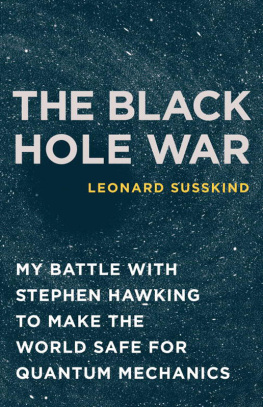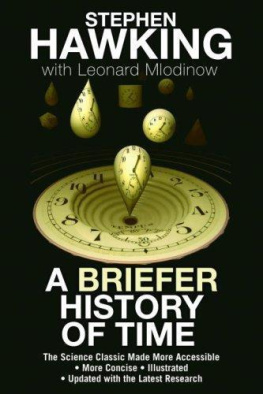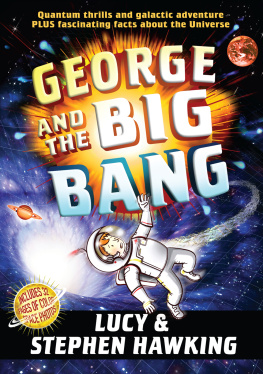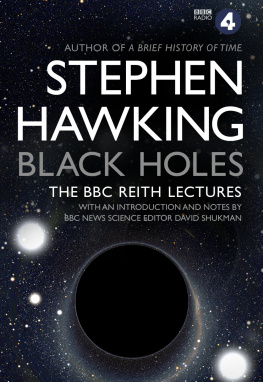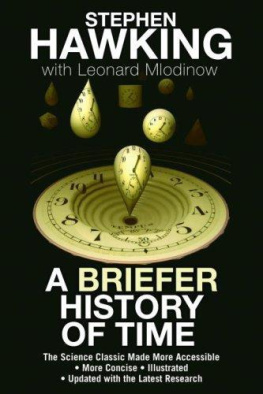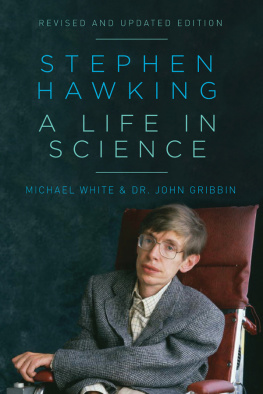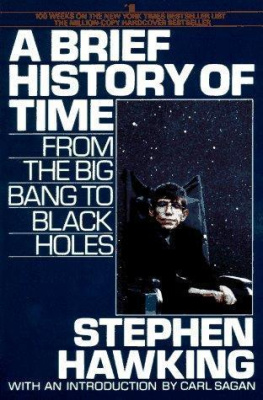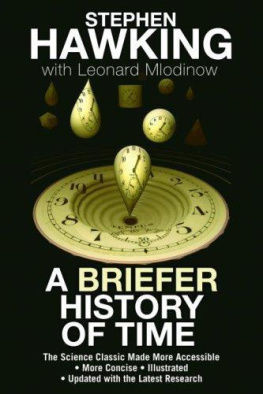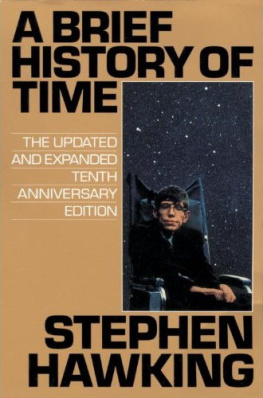Acknowledgments
Thanks to our editor, Ann Harris, at Bantam for lending us her considerable experience and talent in our efforts to hone the manuscript. To Glen Edelstein, Bantams art director, for his tireless efforts and his patience. To our art team, Philip Dunn, James Zhang, and Kees Veenenbos, for taking the time to learn some physics, and then, while not sacrificing the scientific content, making the book look fabulous. To our agents, Al Zuckerman and Susan Ginsburg at Writers House, for their intelligence, caring, and support. To Monica Guy for proof-reading. And to those who kindly read various drafts of the manuscript in our search for passages where clarity could be improved further: Donna Scott, Alexei Mlodinow, Nicolai Mlodinow, Mark Hillery, Joshua Webman, Stephen Youra, Robert Barkovitz, Martha Lowther, Katherine Ball, Amanda Bergen, Jeffrey Boehmer, Kimberly Comer, Peter Cook, Matthew Dickinson, Drew Donovanik, David Fralinger, Eleanor Grewal, Alicia Kingston, Victor Lamond, Michael Melton, Mychael Mulhern, Matthew Richards, Michelle Rose, Sarah Schmitt, Curtis Simmons, Christine Webb, and Christopher Wright.
ALSO BY STEPHEN HAWKING
A Brief History of Time
Black Holes and Baby Universes and Other Essays
The Illustrated A Brief History of Time
The Universe in a Nutshell
ALSO BY LEONARD MLODINOW
Euclids Window
Feynmans Rainbow
About the Authors
STEPHEN HAWKING is Lucasian Professor of Mathematics at the University of Cambridge; his other books for the general reader include the essay collection Black Holes and Baby Universes and TheUniverse in aNutshell.
LEONARD MLODINOW, his collaborator for this new edition, has taught at Caltech, written for Star Trek: The Next Generation, and is the author of Euclids Window and Feynmans Rainbow and the coauthor of the childrens book series The Kids of Einstein Elementary.
Glossary
Absolute zero: The lowest possible temperature, at which substances contain no heat energy.
Acceleration: The rate at which the speed of an object is changing.
Anthropic principle: The idea that we see the universe the way it is because if it were different, we would not be here to observe it.
Antiparticle: Each type of matter particle has a corresponding antiparticle. When a particle collides with its antiparticle, both are annihilated, leaving only energy.
Atom: The basic unit of ordinary matter, made up of a tiny nucleus (consisting of protons and neutrons) surrounded by orbiting electrons.
Big bang: The singularity at the beginning of the universe.
Big crunch: The singularity at the end of the universe.
Black hole: A region of space-time from which nothing, not even light, can escape, because gravity is so strong.
Coordinates: Numbers that specify the position of a point in space and time.
Cosmological constant: A mathematical device used by Einstein to give space-time an inbuilt tendency to expand.
Cosmology: The study of the universe as a whole.
Dark matter: Matter in galaxies, clusters, and possibly between clusters that has not been observed directly but can be detected by its gravitational effect. As much as 90 percent of the mass of the universe may be in the form of dark matter.
Duality: A correspondence between apparently different theories that lead to the same physical results.
Einstein-Rosen bridge: A thin tube of space-time linking two black holes. See alsoWormhole.
Electric charge: A property of a particle by which it may repel (or attract) other particles that have a charge of similar (or opposite) sign.
Electromagnetic force: The force that arises between particles with electric charge; the second strongest of the four fundamental forces.
Electron: A particle with negative electric charge that orbits the nucleus of an atom.
Electroweak unification energy: The energy (around 100 GeV) above which the distinction between the electromagnetic force and the weak force disappears.
Elementary particle: A particle that, it is believed, cannot be subdivided.
Event: A point in space-time, specified by its time and place.
Event horizon: The boundary of a black hole.
Field: Something that exists throughout space and time, as opposed to a particle that exists at only one point at a time.
Frequency: For a wave, the number of complete cycles per second.
Gamma rays: Electromagnetic rays of very short wavelength, produced in radioactive decay or by collisions of elementary particles.
General relativity: Einsteins theory based on the idea that the laws of science should be the same for all observers, no matter how they are moving. It explains the force of gravity in terms of the curvature of a four-dimensional space-time.
Geodesic: The shortest (or longest) path between two points.
Grand unified theory (GUT): A theory that unifies the electromagnetic, strong, and weak forces.
Light-second (light-year): The distance traveled by light in one second (year).
Magnetic field: The field responsible for magnetic forces, now incorporated along with the electric field into the electromagnetic field.
Mass: The quantity of matter in a body; its inertia, or resistance to acceleration.
Microwave background radiation: The radiation from the glowing of the hot early universe, now so greatly red-shifted that it appears not as light but as microwaves (radio waves with a wavelength of a few centimeters).
Neutrino: An extremely light particle that is affected only by the weak force and gravity.
Neutron: A particle very similar to the proton but without charge, which accounts for roughly half the particles in the nuclei of most atoms.
Neutron star: The cold star that sometimes remains after a supernova explosion, when the core of material at the center of a star collapses into a dense mass of neutrons.
No-boundary condition: The idea that the universe is finite but has no boundary.
Nuclear fusion: The process by which two nuclei collide and coalesce to form a single, heavier nucleus.
Nucleus: The central part of an atom, consisting only of protons and neutrons, held together by the strong force.
Particle accelerator: A machine that, using electromagnets, can accelerate moving charged particles, giving them more energy.
Phase: For a wave, the position in its cycle at a specified time: a measure of whether it is at a crest, a trough, or somewhere in between.
Photon: A quantum of light.
Plancks quantum principle: The idea that light (or any other classical waves) can be emitted or absorbed only in discrete quanta, whose energy is proportional to their frequency, and inversely proportional to their wavelength.
Positron: The (positively charged) antiparticle of the electron.
Proportional: "X is proportional to Y" means that when Y is multiplied by any number, so is X. "X is inversely proportional to Y" means that when Y is multiplied by any number, X is divided by that number.
Proton: A particle very similar to the neutron but positively charged, which accounts for roughly half the particles in the nuclei of most atoms.
Quantum mechanics: The theory developed from Plancks quantum principle and Heisenbergs uncertainty principle.
Quark: A (charged) elementary particle that feels the strong force. Protons and neutrons are each composed of three quarks.
Radar: A system using pulsed radio waves to detect the position of objects by measuring the time it takes a single pulse to reach the object and be reflected back.
Next page

